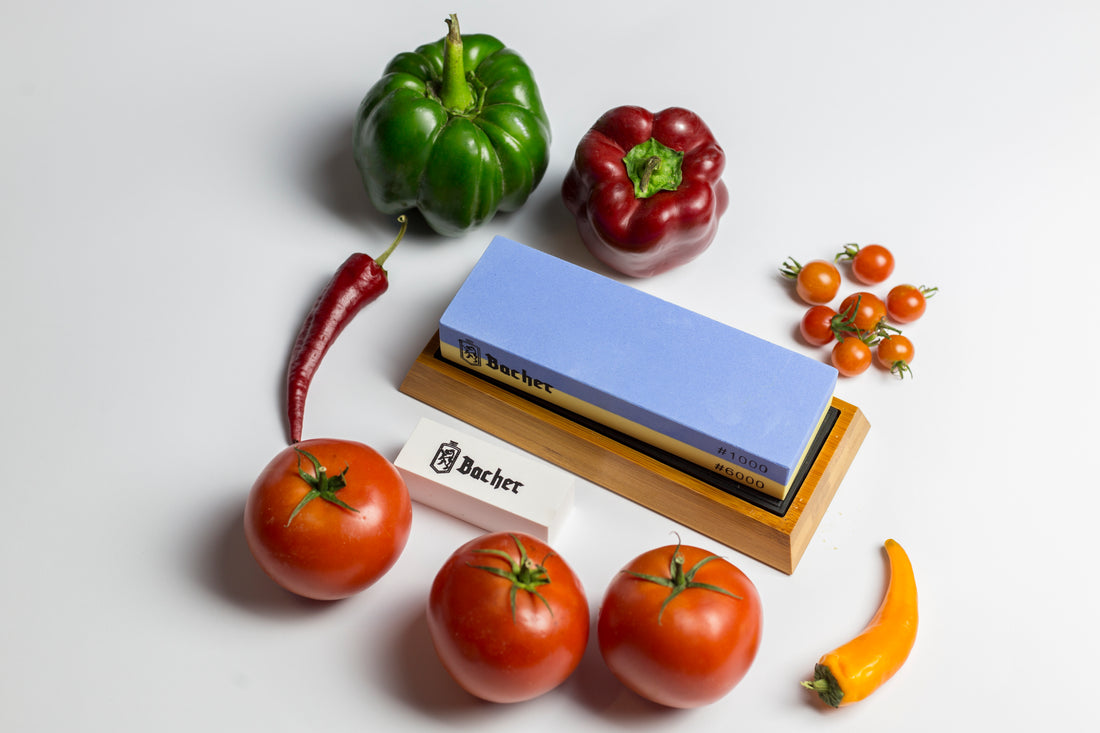Selecting the gradation, i.e. the grit size of the stone, is the first and necessary step in preparing knives for sharpening. The gradation of sharpening stones is marked numerically and the number describes the number of abrasive particles per square centimetre. The lower the number, the rougher the sharpening, so stones with low numbers are used for initial sharpening and to define the shape of the blade. Stones with higher gradations, on the other hand, allow you to complete the sharpening process and polish the blade precisely.
Sharpening knives is an essential skill for any chef. Whether you're chopping vegetables for a salad or portioning meat, a sharp knife makes the job easier and safer. You can easily sharpen a dull knife at home, provided you choose the right sharpener.
What do the numbers on the stones mean?
There is a wide range of knife sharpeners on the market, but the most popular and recommended type of knife sharpener is the whetstone. This type of sharpener is usually available in a number of variations, and what distinguishes them is the gradation of the stone. And this is the key to effective sharpening that gives satisfactory results. Anyone new to waterstones has probably noticed that they have different numerical markings. They refer to the grit of the stone and tell us whether the stone is fine or coarse, and therefore what its purpose is. Choosing the right grit is essential to achieve the best results. Generally speaking, a finer grit stone should be used for finishing the blade and a coarser grit stone for sharpening.
Types of waterstones by grit size
In this article we will discuss the different types of sharpening stones and how to choose the right one for your needs.
There are three main types of whetstones:
- Coarse stone (200-800)
- Medium stone (1000-3000)
- Finishing stone or fine stone (4000-8000)
To choose the right sharpening stone for your knife, consider the effects of each grade:

Coarse grit stone (200-800)
When sharpening knives, the purpose is to remove material from the blade. The coarse-grained stone removes a large amount of material quickly, making it ideal for shaping a dull blade or restoring a damaged edge. These stones have a large grit, usually less than 1000.
Basically, the lower the grit, the thicker the stone. While a coarse stone can quickly sharpen a dull blade, it can also damage it if used incorrectly. For this reason, a coarse stone should only be used on damaged blades with nicks and scratches on the edge.
Medium stone (1000-3000)
As the name suggests, the medium stone falls between the coarse stone and the finishing stone. This type of stone has a grit between 1000 and 3000. You could say that a medium stone is an excellent option for general sharpening, but like the coarse and fine stones, it's not better at one task than the other.
Balancing the scale at 2000 means that stones below 2000 grit should not be used for regular maintenance and sharpening, but they can restore badly worn knives to an acceptable standard. Stones above 2000 grit can be used sparingly as finishing stones.
Finishing stone (4000-8000)
Chefs and culinary experts refer to the grindstone as the 'holy grail' of knife sharpening. This type of whetstone for sharpening knives has a grit ranging from 4000 to 8000. In general, the higher the grit, the finer the stone.
Although these stones can take a long time to use, they do produce a razor-sharp edge that is smooth and consistent. However, we can think of the 4000 grit as a bridge between sharpening and polishing knives.
These grits are for finer polishing, while those above 6000 are for very fine polishing. Chefs use whetstones on already sharp knives to give them an even sharper edge.
Summary
Sharpening your knives regularly will help you avoid a situation where the blade becomes extremely dull and damaged. However, if you have such a knife, a low-grit stone will work for you. For everyday use, however, stones in the middle range, i.e. 1000-3000, are best. You will find all the gradations here, so knowing your needs will help you choose the right stone for your knives.

